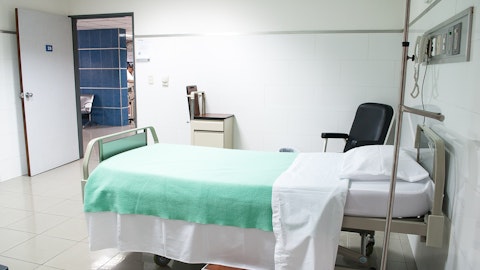Adam Waldman: Yes. So let me — I guess I can take — You want me to go, Mike?
Michael Weiss: Yes, go ahead. Yes. Go ahead.
Adam Waldman: Okay. Yes. So to the first part of your question, yes, our strategy is to continue to increase enrollments and continue to find new business, adding new centers and new prescribers, obviously, is important. But at the same time, deepening experience seems to be something that’s leading to more experience. I will say in this market that as physicians are getting used to the product or they want to try it, they want to see how it goes. They want to see how reimbursement goes and then they’ll — once they have that experience, they — and it goes well, then they will continue to add. So we’re getting to the point here now where many, many physicians have had that experience now, they’ve gotten reimbursed and now they’re willing to expand their base.
So I think that’s — we’ll continue to lean in there. But I think there’s plenty of opportunity here for us to expand usage into new centers and new prescribers. We’ve made great progress but there’s plenty of opportunity for us to continue to grow both in academic centers as we’ve mentioned, is an area that has been slightly slower to adopt. It’s increasing but it’s been slightly slower. We think there’s plenty of room in academic centers to increase. And then just in general, I mean, we’re — again, we’re making good progress on penetration with our top prescribers but there’s a lot of room for us to continue to grow. And then the second part of your question was the 15%. Yes, I’m just — what we’re doing there is just — we don’t know obviously what our drop-off rate is going to look like.
But we — there is published data out there with the other IV CD20. We’ve looked at it and it’s about a 15% that they’re losing between dose 1 and — the first dose and the week or the 6-month dose.
Eric Joseph: Okay. In your hub, do you have visibility on week 24 prescriptions versus starting prescriptions? And is that sort of a metric that you anticipate providing or updating the street on going forward?
Adam Waldman: Yes, we don’t get those. No, we don’t necessarily get those. We get the first ones to come in. And then once they’re in our hub then we are — what we’re doing is we’re — as they come up for their week 24 dose, we’re reaching out to them. There’s no requirement to come back into our hub at that point. But we’re reaching out to them to see what we can do to help with the reverification of insurance benefits and so on and so forth. But note that we don’t have access or visibility to the week 24 scripts.
Operator: Our next question is from Prakhar Agrawal with Cantor Fitzgerald.
Prakhar Agrawal: Thank for taking my questions and congrats on the quarter. Maybe first question on the switches from Ocrevus, is this a trend that you think versus into next year? Or is there some sort of a bolus of Ocrevus patients wanting to switch initially maybe due to tolerability issues? Any color for — would be appreciated?
Michael Weiss: Yes, I’ll take a crack at that, Adam, you could join in. I mean, based on my interactions with health care providers and even with our own folks, I would say that, that’s something that would at least stay constant, if not grow over time. I think the more patients who go on Briumvi, the more patients will be interested in going on Briumvi. So if you’re reasonably satisfied or somewhat unsatisfied but not horribly unsatisfied with your current CD20, you still may consider changing, you just want to see more utilization. So we’ve heard that from HCPs. I’ll talk to some of the Ocra patients who are potentially candidates and they’ll say, hey, I just want to wait a little longer to see more on market experience, hear more stories from you and your patients and how things are going.
So I don’t think it’s — it was about any sort of bolus. I do think it’s about organic demand that will occur over time as more and more people see the potential benefits of switching over. Adam, any further thoughts on that?
Adam Waldman: No, I think you covered it, Mike. Thanks.
Prakhar Agrawal: Got it. And second question on expenses. So the expenses for 3Q were at the lower end of your OpEx guidance, excluding share comp and inventory build. So any one-offs for this quarter we should be aware of has been more of 4Q? And as a follow-up, any initial thoughts whether you expect a significant infection and expense growth trajectory for next year? Or is it more about steady growth?
Michael Weiss: Yes. I’ll take the second part of that and Sean, maybe hit the expense question. In terms of any inflection in expenses, no, I think the short answer there is no. We do anticipate that the burn will creep up a bit. We’ve talked about that we’ve always had a plan to modestly expand our team. We’re doing more what I refer to as their support or advertising initiatives, mostly online and social. So we are definitely creeping up on the burn but nothing too dramatic at all. And you’ve also talked about getting more aggressive on the R&D side. But again, nothing that will dramatically change or show any sort of major inflection in expenses. We’ve been saying that our operating burn is between $40 million and $50 million.
But in fact, it’s been slightly lower than that over the last 2 quarters in terms of true operating. So we have room to be within the $40 million to $50 million and should be pretty unnoticeable from a financial standpoint. Sean, do you want to answer the question on the expense side?
Sean Power: Yes. Prakhar, would you mind just clarifying your question as early…
Prakhar Agrawal: Right. So yes, for 3Q, it was at the lower end of your OpEx guidance, $40 million to $50 million for 3 — for the quarter. So maybe any color on whether there were any one-offs or you — and how should we think about the 4Q number?
Sean Power: Yes. No one-offs in the quarter. And I think Mike covered it pretty well as it relates to sort of the fourth quarter next year. So no one-offs in the quarter that really drove things being on the lower end of the range.
Prakhar Agrawal: Okay. Got it. And last question. There’s some interesting data from the BTK drugs in MS. So how do you see those drugs impacting the CD20 class? And I know you had a BTK in the pipeline. Is there any plan to take that forward into MS?




